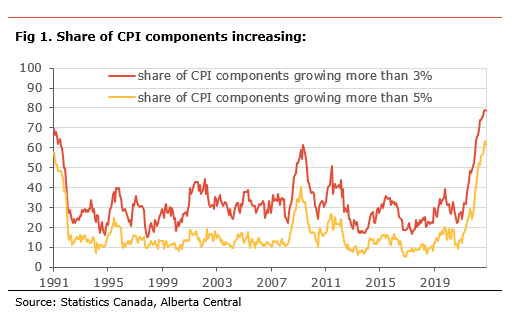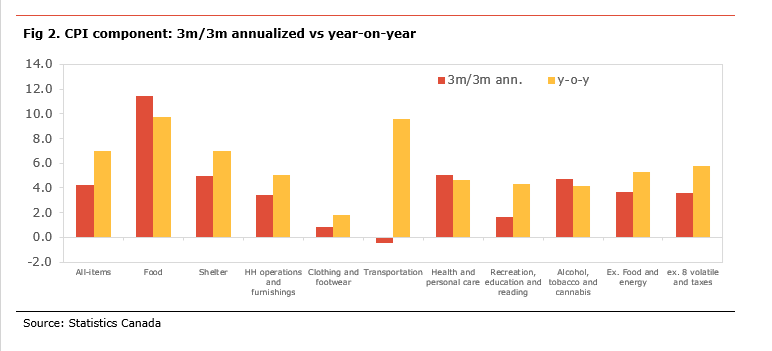Economic insight provided by Alberta Central Chief Economist Charles St-Arnaud.
Bottom line
Inflation remained unchanged in October at the elevated level of 6.9%. However, the headline number covers some divergences in the components, with a rise in transportation costs, due to higher gasoline prices offsetting a moderation in food prices and some other components. Inflationary pressures remain broad, with almost 80% of the components of CPI rising at more than 3% y-o-y and more than 60% at more than 5% y-o-y (see Fig 1). However, we note that both measures are marginally lower than the previous month, suggesting that inflationary pressures are no longer broadening. Moreover, while the BoC’s measures of core inched higher in October, other measures, like CPI excluding food and energy or the old Bank of Canada measure, eased in October. These could be pointing to a peak in underlying inflationary pressures.
The recent trend in the CPI monthly changes suggests that inflationary pressures are losing momentum and weakening. As such, the 3-month annualized change in most CPI components is below their year-on-year changes, except for food prices, suggesting that inflationary pressures may be close to peaking (see Fig. 2). However, the 3-month annualized changes remain elevated and well above 3%, the upper end of the BoC’s target
While inflation may be peaking, it remains well above the BoC’s target of 2%, inflation expectations are rising, and inflationary pressures remain broad. With this in mind, we believe the Bank of Canada will continue to hike interest rates. In our view, the BoC will likely increase its policy rate by 25bp at the December meetings. However, with inflationary pressures remaining high and little signs of sustained deceleration in underlying inflation, there is a risk the BoC could hike 50bp.
In Alberta, inflation rose to 6.8%. An acceleration in transportation costs, as gasoline prices jumped on the month following the reinstatement of the gasoline tax and higher retailer margins, was the main cause of the rise in inflation. Inflation excluding food and energy (a measure of core inflation) rose to 5.3%, its highest since 2003. We note that core inflation in Alberta is now on par with in the rest of Canada, after underperforming since early 2021.
The Consumer Price Index (CPI) increased by 0.7% m-o-m non-seasonally-adjusted in October. Despite the strong m-o-m change, the inflation rate remained unchanged at 6.9. Prices rose on the month in seven of the eight major CPI components, wth only recreation, education and reading showing a decline on the month (-0.2% m-o-m). The biggest increases were in transportation (+1.7% m-o-m), due to a sharp rise in gasoline prices (+9.2% m-o-m), clothing and footwear (+1.7% m-o-m), and shelter (0.8% m-o-m). The rise in the shelter component was mainly the result of higher property taxes, mortgage interest costs and utilities.
Five of the eight major CPI components acccelerated in October on a year-on-year basis, led by transportation costs. Transportation costs accelerated to 9.5% y-o-y, contributing 1.6pp to inflation, with gasoline prices being the primary source of cost increases in the category (+17.8% y-o-y contributing 0.8pp). Shelter costs accelerated to 6.9% y-o-y (contributing 2.1pp), as owned accommodation costs inflation increased due to higher mortgage interest and property taxes. These accelerations in inflation were offset by food prices inflation decelerating to 10.1%, still close to its highest since 1981, contributing 1.6pp to inflation.
In October, goods prices inflation decelerated to 8.4% from 8.2%, mainly due to higher gasoline prices, and services inflation moderated to 5.4% from 5.6%. Energy prices also accelerated, increasing by 16.2% since October last year. Excluding food and energy, prices increased 0.3% on the month and rose by 5.3% compared to the same month last year, marking a slight deceleration. The Bank of Canada’s old measure of core inflation, CPI excluding the 8 most volatile components and indirect taxes, also edged lower to 5.8%.
Looking at the BoC’s core measures of inflation, two out of three accelerated in October. CPI-Trim rose to 5.3% from 5.2% and CPI-Median at 4.8% from 4.7%. CPI-Common remained unchanged at 6.2%. The average of the core measures edged higher to 5.4%.
In Alberta, inflation rose to 6.8% in October from 6.2%. Higher transportation costs were the main reason for the higher inflation, increased by 9.9% y-o-y and contributing 1.8pp to inflation. Higher gasoline due to the reversal of the gasoline tax cut and higher gasoline station margins were partly responsible for higher prices. Shelter costs accelerated on the month, rising 6.7% y-o-y from 6.2%, contributing 1.7pp to inflation. The rise in shelter costs was broad-based with an increase in rented accommodation, owned accommodation and utilities, especially natural gas. Food prices rose 10.3% compared to last year and remain an important source of inflation, contributing +1.7pp. Goods price inflation accelerated to 8.2% from 7.0%, while services prices rose to 5.4%. Inflation excluding food and energy rose to 5.5%, its highest level since 2003, while energy costs to +18.1% y-o-y compared to the same month last year, after 6.7% y-o-y the month before.





Independent Opinion
The views and opinions expressed in this publication are solely and independently those of the author and do not necessarily reflect the views and opinions of any organization or person in any way affiliated with the author including, without limitation, any current or past employers of the author. While reasonable effort was taken to ensure the information and analysis in this publication is accurate, it has been prepared solely for general informational purposes. There are no warranties or representations being provided with respect to the accuracy and completeness of the content in this publication. Nothing in this publication should be construed as providing professional advice on the matters discussed. The author does not assume any liability arising from any form of reliance on this publication.
Alberta Central member credit unions can download a copy of this report in the Members Area here.